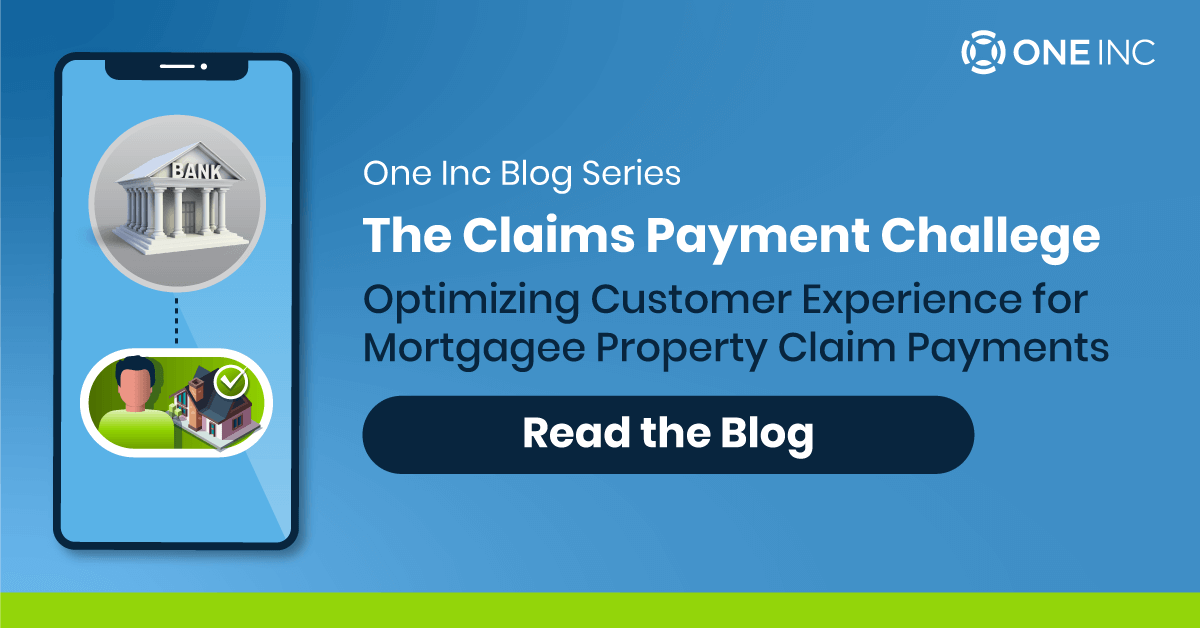| By Anne Freitas

Optimizing the Customer Experience for Mortgagee Property Claim Payments (Claim Payment Challenge Part 3)
In part 2 of this four-part series, we took a deeper look into the pain points of lienholder payment, what’s involved with the auto total loss process, and the benefits digitization can provide. Here in part 3, we delve into the cumbersome process of mortgagee property claim payments, the difference between monitored and non-monitored claims, and the opportunity to optimize the customer experience.
Property Damage Can Happen Any Time
Fire, wind, hail, water…all can unexpectedly wreak havoc on a property. When property damage or disaster occurs, homeowners are suddenly thrown into a stressful and tenuous living situation. It’s critical that they have the ability to get their lives back to normal as quickly as possible. That’s where homeowner’s insurance comes into play. Any damage or loss needs to be reported immediately to the insurance company covering the home so that the claim review process can begin. An insurance adjuster will review the relevant information related to the damage and determine the estimate for the necessary repairs. Once agreement on the claim settlement amount is reached, a check will be sent out to the insured.
When the Home Has a Mortgage
If a mortgage exists on the home, most mortgage lenders require that they be listed as the ‘mortgagee’ on the homeowner policy since they have a financial interest in the property and its condition. To protect their asset, the mortgage lender needs to ensure that the property is repaired correctly. The claim settlement check will then generally be issued as a multi-party check, made out to both the homeowner and the ‘mortgagee’, and mailed to the insured. Before the insured can access funds and repairs can begin, the check will need to be received and endorsed by the lender. This adds significant delays and complications to an already difficult situation. It takes time for a paper check to get processed, mailed, and received by the homeowner. Once received, the homeowner will need to determine what steps to take to get the check endorsed. Who exactly should they contact at the mortgage lender? What information will the mortgage lender need? How much longer will it now take to access the funds necessary to start the search for a contractor and begin repairs? An already difficult situation becomes that much more stressful due to external factors beyond the homeowner’s direct control.
Non-Monitored vs. Monitored Claims
At a minimum, the mortgagee will need to know details around the loss and receive the insurance adjuster’s repair estimate. Once the information is received and reviewed, the mortgagee will determine if the property damage claim will be ‘non-monitored’ or ‘monitored’. Although each mortgage lender will have their own criteria to make this determination, the dollar amount of the claim and the payment history of the insured ultimately drive the decision. Most claims under $15k will be considered ‘non-monitored’ and the mortgagee will endorse the check to release the funds to the homeowner. Fortunately, the majority of property damage claims (60%– 80%) fall into this category.
Those claims that run over that dollar threshold, or have other more complex factors, fall into the ‘monitored’ claim category. For a monitored claim, the mortgagee gets more involved in the repair process, although the specific approach taken can vary depending upon the mortgage lender and state. Instead of releasing the property damage settlement check to the homeowner, the mortgagee usually places the funds into an escrow account to pay for repairs as work is completed, normally in 3 installments – when work begins, half-way through, and then when the work is completed. That allows the mortgagee to protect their financial interest and ensure the home is properly repaired. To initiate the process, the mortgagee will work with the insured to obtain their check endorsement for the funds to be deposited in the escrow account.
The Moment of Truth
Homeowners expect that if they have insurance, they will be taken care of when there is damage to their home. They count on the fact that at their greatest time of need, when their home needs repair and their daily life has been upended, that their insurance company will do all they can to get funds to them quickly. But even if the insurance adjuster has been able to settle the claim expediently, having the added complication of a multi-party mortgagee claim payment can cause the insured to wait weeks to months longer to even get the repair process started, not to mention the amount of frustration and burden that’s added to the homeowner’s experience.
Optimizing the Customer Experience
When property damage occurs on a home with a mortgage, how can an insurer optimize the customer experience? The complications and delays involved with the cumbersome, complex and frustrating mortgagee claim payment process can be significantly reduced and even eliminated by selecting a comprehensive digital payment platform purpose-built for insurance. With established insurance-centric processes and an extensive mortgage lender network, streamlined digital information exchange and digital payment are both rapid and frictionless. Bank decisions and fund access can occur in less than a day. Property repairs can begin, and homeowners can start to put their lives back together. Insurers not only reduce the risk of additional property damage occurring, they also significantly optimize the customer experience.
Stay tuned for Part 4 of our Claim Payment Challenge Series where we take a deeper look into the world of vendor payments, the complexity medical claims add, the value of real-time reconciliation, and the benefit digital payment provides.
The Claim Payment Challenge Blog Series:
Tags: Payments, Mortgagee Claim

Want to read more articles like this?


